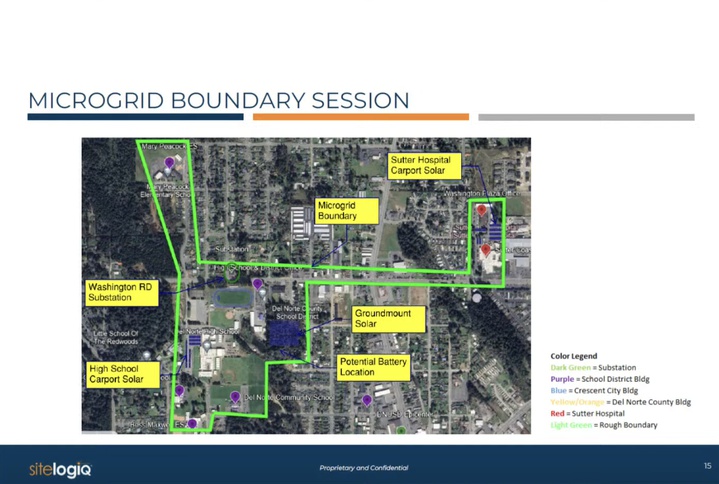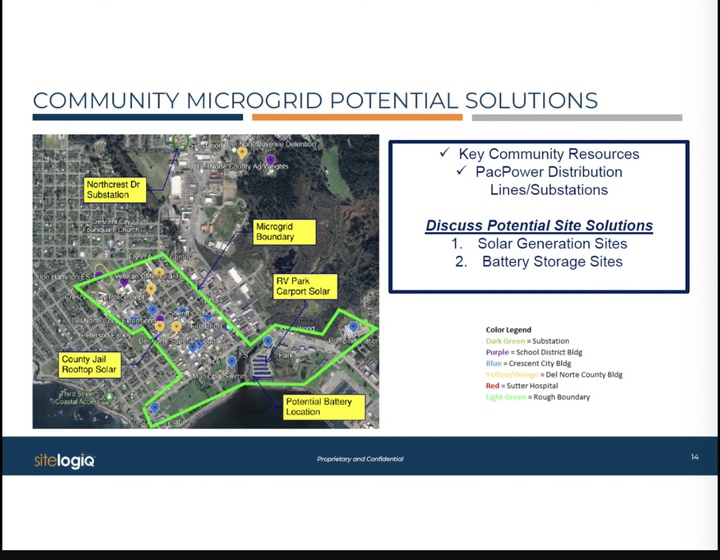Jessica Cejnar Andrews / Friday, Sept. 27, 2024 @ 10:14 a.m. / Emergencies, Infrastructure, Local Government
SiteLogIQ Lays Out Proposed Microgrid Project That Could Electrify Del Norte's Critical Infrastructure During Emergencies

SiteLogIQ presented a project proposal on Tuesday that included using a micro grid to cover critical areas in the northern and southern area of Crescent City. | Screenshot
Previously:
###
Chris Howard urged his colleagues to take SiteLogIQ’s proposal to use microgrids as a way to keep Del Norte County’s critical infrastructure going in an emergency seriously.
Despite one Del Norter's assertion that diesel generators would be enough to cover those areas, the District 3 Supervisor pointed out it took 53,000-plus gallons of fuel per day to run the industrial-sized generators that kept Del Norte County going during the Smith River Complex wildfires.
During the 1964 flood, Del Norte County was “cut off from the world” without diesel, Howard said, while the threat of earthquakes and tsunamis is constant
“Diesel is not necessarily the answer,” he said Tuesday. “We need to provide more site-secure redundancy in order to power up our critical infrastructure to keep our essential services operating…. This could be the quickest solution to provide that security this community needs.”
Howard, with support from his colleagues, asked Del Norte County staff to work with SiteLogIQ to put together a letter of agreement to move forward with the proposed microgrid project.
Company representatives Kristy Coughlin and Taylor Boyle laid out two proposed projects in the Crescent City area.
The first would tap into a Pacific Power substation on Washington Boulevard and supply electricity to Del Norte Unified School District, Crescent Fire Protection District, Del Norte High School and Sutter Coast Hospital.
Boyle, SiteLogIQ’s director of project development, said that since this area is outside of the tsunami inundation zone and less prone to flooding, it could be a first project.
The second phase would incorporate a substation on Northcrest Drive and power the city’s wastewater treatment plant, city hall and police station as well as the Flynn Center, the sheriff’s office and courthouse.
Boyle said the microgrid will be powered by several different energy sources, including a generator and solar panels, and will have battery backups to store excess energy.
“And then all of those microgrid components will be backing up your community infrastructure, whether that be your schools, hospitals grocery stores, gas stations — all of the critical needs you have in the community,” she said.

The southern part of the project would ensure redundant electricity for county and city offices, the police department, sheriff's office and courthouse. | Screenshot
Boyle said Del Norte County spends more than $220,000 on electricity annually with the sheriff’s office consuming the most energy and costing $70,537 per year, and the airport coming in second at $42,021 annually.
SiteLogIQ can also help the county determine what energy and cost-savings measures they can take for each of their buildings, Boyle said, and how that would integrate into the overall microgrid. This will ensure Del Norte County backs up the least amount of power possible, she said.
“So you can minimize [and] reduce first and then provide the resilience overall,” Boyle said.
Potential partners could include the Del Norte County Office of Education, Crescent City and Sutter Coast Hospital, Boyle said.
Coughlin mentioned California Government Code 4217, which requires that microgrid projects are self-funded and that over their life they bring a net savings in energy costs. They’re often paid for with federal and state grants and low-interest loans, she said.
Greg Orsini, a former operations director and general manager and current Board member for the McKinleyville Community Services District, said his organization was looking at an increase in electricity costs from $48,000 to $160,000 annually after it was forced to upgrade its wastewater treatment system.
The community urged the CSD to install solar panels as a way to save on those costs, Orsini said, but the Board realized that a microgrid is better if you want resiliency.
“Our system has solar panels, it has battery backup and it also has an emergency diesel generator,” he said. “You need all three of those for resiliency. If you don’t plan to have multiple means of power, you’re going to get caught short.”
The system the McKinleyville CSD uses provides 500,000 kilowatts of electricity and has 750,000 kilowatt hours of battery storage, Orsini said. His community’s energy demands are about 66,000 kilowatt hours per month and in the summer, the microgrid generates 19,000 more kilowatt hours than it consumes.
McKinleyville used a Statewide Water Resources Control Board Energy Efficiency Grant to install its microgrid project.
“It was about a $4 million project for half a megawatt and 750,000 kilowatt hours of battery storage,” Orsini told supervisors. “We had some growing pains. PacPower’s going to want to work with you, but they don’t know what they don’t know. Don’t be disillusioned by that.”
During the wildfire, representatives with the now-defunct Tri Agency Economic Development Authority began advocating for a redundant electricity source. On Tuesday, Howard said there are discussions around reconnecting Del Norte with the transmission line that serves Curry County. However, the projected cost to do that is about $80 to $90 million, he said.
Noting that Pacific Power only has a customer base of about 56,000 people in California, coming up with the $80-90 million to reconnect with the Curry County transmission line wouldn’t be a quick endeavor, Howard said.
“I don’t think, even with Pacific Power’s willingness, they’re going to be able to pull the trigger for us with a Curry County connection within the next decade without a major lift from the federal government,” he said. SiteLogIQ’s proposal “focuses our energy in a combined way on those essential services and allows us to take the next step toward redundancy and resiliency.”
The proposal wasn’t without its skeptics. Sam Strait said that after living in Del Norte County for 50 years, apart from last summer’s wildfire, power outages have lasted less than 48 hours. Though he didn’t acknowledge that SiteLogIQ’s proposal is to power the hospital and other critical infrastructure, Strait said he didn’t think a microgrid would offer an alternative electric source for him personally.
“It boils down to, if we only have this event once every 50 years, how much is this going to cost us to provide the redundancy for once in 50 years?” He asked. “Nothing is free. It’s likely to be a substantial cost to somebody.”
Jonnel Covault, a member of the Del Norte Energy Resilient Committee, said a lot of people struggled during the power outage last summer. She said she envisions more problems in the future due to a warming planet and embarking on a project to use microgrids to increase the community’s resilience is forward thinking, she said.
“I would hope the Board of Supervisors would maybe form an ad-hoc committee so people in the community can be more involved in this process and know what’s going on,” she said.
CLICK TO MANAGE